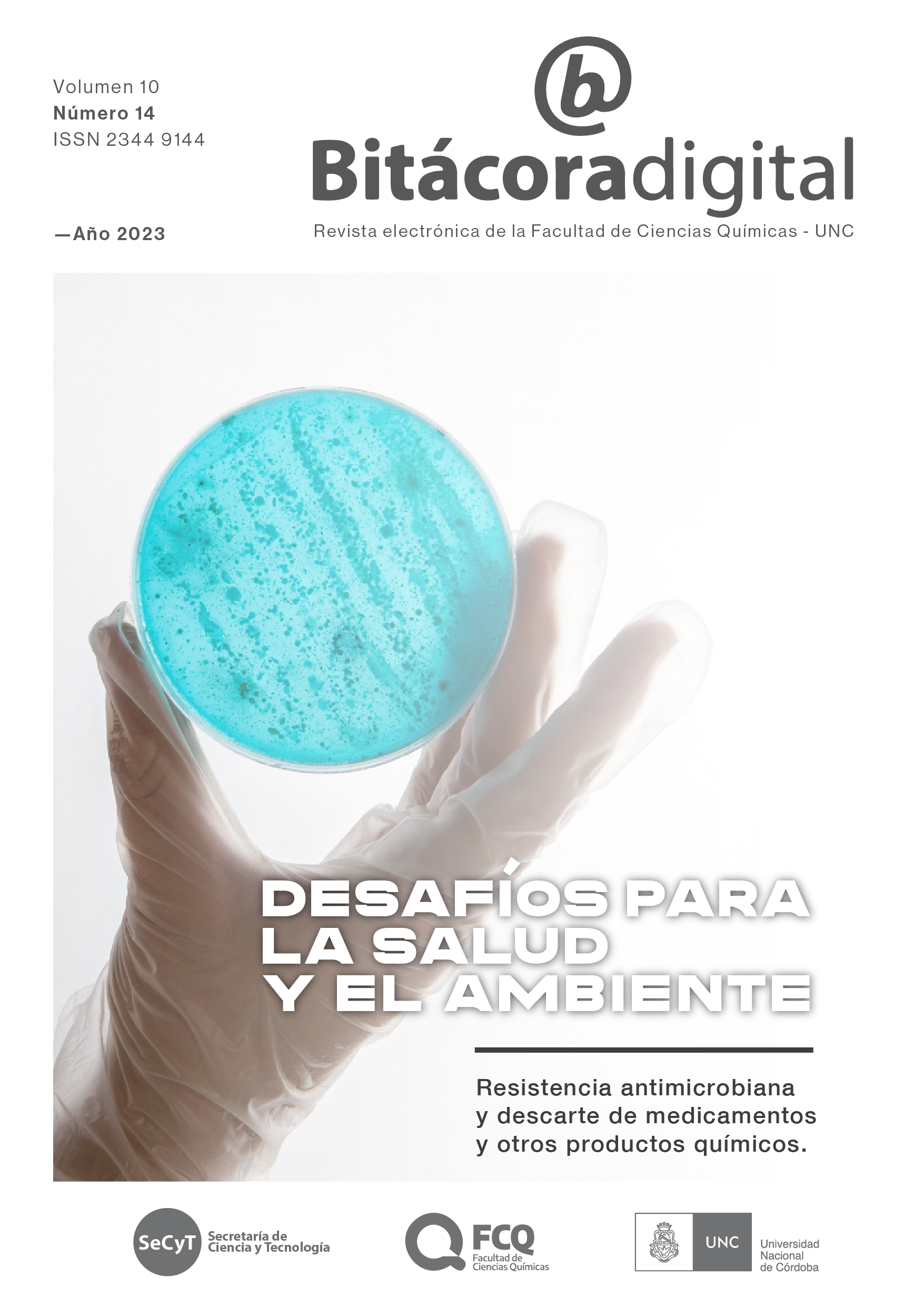Antibióticos ¿contaminantes de preocupación emergente en Córdoba? :
antibióticos en sistemas acuáticos
Abstract
Antibiotics are among the contaminants of emerging concern contributing to the emergence, selection, and spread of antibiotic-resistant bacteria. The presence and concentration of antibiotics in the Suquía River and in fish for consumption is reported. Additionally, the risk to aquatic biota and human consumption was calculated.
References
Sauvé, S., Desrosiers, M., 2014. A review of what is an emerging contaminant. Chem.Cent. J.
8–15. https://doi.org/10.1186/1752-153X-8-15.
Bertrand, L.; Iturburu, F.G.; Valdés, M.E.; Menone, M.L.; Amé, M.V., 2023. 64 Risk evaluation
and prioritization of contaminants of emerging concern and other organic micropollutants in two
river basins of central Argentina. Sci. Total Environ. 878, 163029. http://dx.doi.org/10.1016/j.scitotenv.
2023.163029
Valdés, M. E.; Santos, L.H.M.L.M.; Rodríguez Castro, M. C.; Giorgi, A.; Barceló, D; Rodríguez-
Mozaz, S.; Amé, M. V., 2021. Distribution of antibiotics in water, sediments and biofilm in
an urban river (Córdoba, Argentina, LA). Environ. Poll. 269, 116133.https://doi.org/10.1016/j.envpol.
2020.116133
Chacón, L; Reyes, L.; Rivera-Montero, R.; Barrantes, K., 2022. Chapter 5 - Transport, fate, and
bioavailability of emerging pollutants in soil, sediment, and wastewater treatment plants: potential
environmental impacts, Editor(s): Hemen Sarma, Delfina C. Dominguez, Wen-Yee Lee, Emerging
Contaminants in the Environment, Elsevier, 2022, Pages 111-136. https://doi.org/10.1016/B978-0-323-85160-
2.00020-2.
Carrizo, J.C., Griboff, J., Bonansea, R.I., Nimptschc, J., Valdés, M.E., Wunderlin, D.A., Amé, M.V., 2022. 56. Different
antibiotic profiles in wild and farmed Chilean salmonids. Which is the main source for antibiotic in fish? Sci. Total
Environ. 800, 149516. https://doi.org/10.1016/j.scitotenv.2021.149516
Lulijwa, R., Rupia, E. J., Alfaro, A. C., 2019. Antibiotic use in aquaculture, policies and regulation, health and environmental
risks: a review of the top 15 major producers. Rev. Aquac. 12(2), 640–663. https://doi.org/10.1111/
raq.12344
Shen, X., Jin, G., Zhao, Y., Shao, X., 2020. Prevalence and distribution analysis of antibiotic resistance genes in a large-
scale aquaculture environment. Sci. Total Environ. 711, 134626. https://doi.org/10.1016/j.scitotenv.2019.134626
Griboff, J., Carrizo, J.C., Bonansea, R.I., Valdés, M.E., Wunderlin, D.A., Amé, M.V., 2021. Multiantibiotic Residues in
Commercial Fish From Argentina. The Presence of Mixtures of Antibiotics in Edible Fish, a Challenge to Health Risk
Assessment. Food Chem. 332, 127380. https://doi.org/10.1016/j.foodchem.2020.127380
Ministry of Agriculture the PRC (Ministry of Agriculture of the People's Republic of China). Bulletin (NO. 235): The
Guideline of Maximum Residue Limits for Veterinary Drugs in Animal Food, 2002.
Downloads
Published
Issue
Section
License

This work is licensed under a Creative Commons Attribution-NonCommercial-ShareAlike 4.0 International License.
Licencia Creative Commons BY NC
Usted es libre de:
- Compartir — copiar y redistribuir el material en cualquier medio o formato
- Adaptar — remezclar, transformar y construir a partir del material
- La licenciante no puede revocar estas libertades en tanto usted siga los términos de la licencia
Bajo los siguientes términos:
-
Atribución — Usted debe dar crédito de manera adecuada, brindar un enlace a la licencia, e indicar si se han realizado cambios. Puede hacerlo en cualquier forma razonable, pero no de forma tal que sugiera que usted o su uso tienen el apoyo de la licenciante.
-
NoComercial — Usted no puede hacer uso del material con propósitos comerciales.

